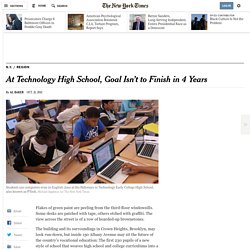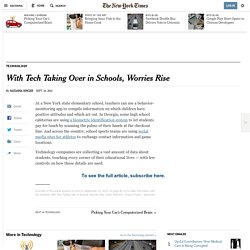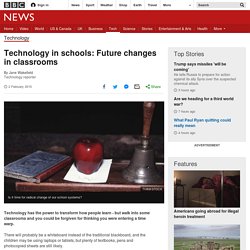

Integrating Tech in High School. High school teachers face enormous pressure to prepare students for state standardized tests, college admissions tests, and AP exams.

Do computers "get in the way" of teaching in such an environment or can technology improve achievement without taking time away from the curriculum? Education World's Tech Team offers opinions on the reality and possibilities of "teching" in high school. Included: Nine easy ways to integrate technology in high school.
AP exams...college admissions tests....the dreaded state standardized tests...no matter where you are in America, if you teach high school, you're probably teaching to a test. Almost everything you do in the high school classroom seems to revolve around test success, and much of that means cramming students with equations, dates, concepts, vocabulary, and more. Is there room for computers in this quest for test success? It might be, however, that some high school teachers view technology differently than others. A Brooklyn High School Takes a New Approach to Vocational Education. Photo Flakes of green paint are peeling from the third-floor windowsills.

Some desks are patched with tape, others etched with graffiti. The view across the street is of a row of boarded-up brownstones. The building and its surroundings in Crown Heights, Brooklyn, may look run-down, but inside 150 Albany Avenue may sit the future of the country’s vocational education: The first 230 pupils of a new style of school that weaves high school and college curriculums into a six-year program tailored for a job in the technology industry. #1. With Tech Taking Over in Schools, Worries Rise. Photo At a New York state elementary school, teachers can use a behavior-monitoring app to compile information on which children have positive attitudes and which act out.

In Georgia, some high school cafeterias are using a biometric identification system to let students pay for lunch by scanning the palms of their hands at the checkout line. And across the country, school sports teams are using social media sites for athletes to exchange contact information and game locations. Technology companies are collecting a vast amount of data about students, touching every corner of their educational lives — with few controls on how those details are used.
Now California is poised to become the first state to comprehensively restrict how such information is exploited by the growing education technology industry. Gov. James P. “You can’t have an education technology revolution without strong privacy protections for students,” said Mr. The California effort comes at a pivotal time for the industry. Transforming Schools with Technology. Andrew A.

Zucker In 1974, when I became director of Milton Academy's "computer center," it consisted of a single noisy teletype machine connected by a leased phone line to a computer at Babson College. Consider Online College Courses in High School. As a high school student, Holly Harvey was determined to take as many college courses as possible.

There was just one problem – the nearest community college was 45 minutes away from her home in Carrollton, Texas. And she didn't have her driver's license. So Harvey got creative and signed up for an online course at the community college. By the time she earned her high school diploma, she had already completed 45 hours of classes that could be applied toward a college degree. "I was able to graduate from college with two degrees in three years," says Harvey, who was thrilled to save money by graduating early. [Discover the basics of an online class.] Enrolling in an online college course can have a variety of benefits for high school students.
But the courses aren't for everyone, experts say. 1. Technology in schools: Future changes in classrooms. Image copyright Thinkstock Technology has the power to transform how people learn - but walk into some classrooms and you could be forgiven for thinking you were entering a time warp.

There will probably be a whiteboard instead of the traditional blackboard, and the children may be using laptops or tablets, but plenty of textbooks, pens and photocopied sheets are still likely. And perhaps most strikingly, all desks will face forwards, with the teacher at the front. The curriculum and theory have changed little since Victorian times, according to the educationalist and author Marc Prensky. Benefits of Technology in the Classroom. As we sail through the 21st century, technology in the classroom is becoming more and more predominant.

Tablets are replacing our textbooks, and we can research just about anything that we want to on our smartphones. Social media has become commonplace, and the way we use technology has completely transformed the way we live or lives. Educators, too, have seen firsthand the benefits of technology in the classroom. According to a study by IT Trade Association CompTIA just released this month, around 75 percent of educators think that technology has a positive impact in the education process. Educators also recognize the importance of developing these technological skills in students so they will be prepared to enter the workforce once they complete their schooling. The impact that technology has had on today’s schools has been quite significant. Technology in the Classroom Makes Learning More Fun A few creative teaching strategies to make math a little more interesting.